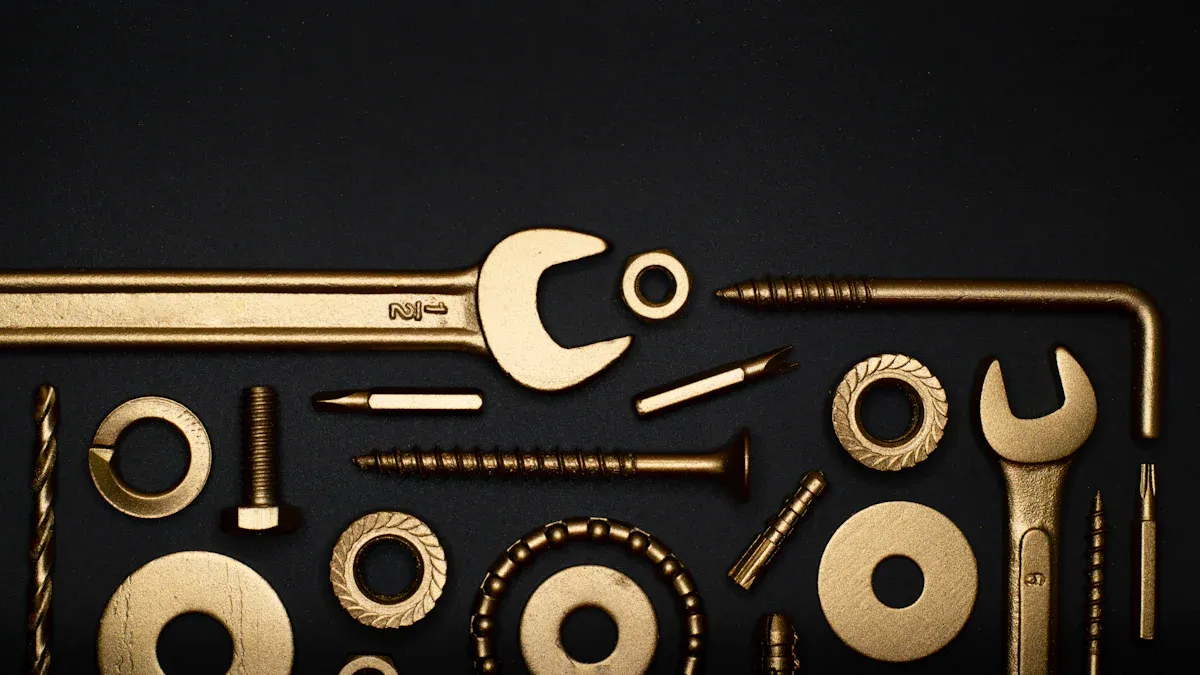
Rivnuts are very important for changing a rivnut bike frame. They help you attach parts tightly, making your bike work better. Installing them correctly lets you change your bike safely and easily. This guide will give you simple steps to install rivnuts on your rivnut bike frame with confidence.
Key Takeaways
Use the correct tools to install rivnuts. You need a 90-degree drill attachment, stepped drill bits, and a rivnut tool for a strong fit.
Get your bike frame ready. Mark where to drill, make pilot holes, and protect the frame for an easy installation.
Do final checks after you install. Make sure the rivnuts are tight, the holes are the right size, and do not over-tighten to keep it strong.
Essential Tools for Installing Rivnuts

When you want to install rivnuts on your bike frame, having the right tools is very important. Here’s a list of tools you need for a good installation:
90 Degree Drill Attachment: This tool is key for drilling in tight spots on your bike frame. It helps you reach hard areas, so you can drill correctly without hurting your frame.
Stepped Drill Bits: These bits work well in small spaces. They help make pilot holes, which are needed for good rivnut installation. Using the right size bit makes sure your rivnuts fit snugly.
Rivnut Tool: This is the main tool! The rivnut tool is needed for putting in the rivnuts. It makes sure they fit tightly, so you can safely attach things like water bottle mounts and other parts to your bike.
Tip: Always check that you have the right size rivnut for your job. Using the wrong size can make a weak connection, which is not what you want when changing your bike.
Types of Rivnuts
Knowing the types of rivnuts can help you pick the right one for your bike frame changes. Here’s a quick look:
Material | Type | Notes |
|---|---|---|
Titanium | Boss | Often found on OEM bosses, especially on Litespeed frames. |
Aluminum | Rivnut | Commonly used in bike frame changes; these rivnuts are not welded in place. |
If you want specific products, here’s a breakdown of a common rivnut option:
Product Name | Material | Thread Diameter | Total Length | Grip Range | Body Diameter | Weight | Package Content |
|---|---|---|---|---|---|---|---|
Rivet Nut | Carbon Steel, Zinc | 5mm | 12mm | 0.5-5.0mm | 7mm | 36g | 150 |
With these tools and types of rivnuts, you’re ready to change your bike frame safely and well. Remember, the right tools make the job easier and keep your changes secure and reliable.
Step-by-Step Process for Rivnut Bike Frame Installation

Preparing the Frame
Before you start putting in rivnuts, get your bike frame ready. This step is very important for a good installation. Here’s how to prepare:
Mount the Frame: Put your bike frame in a stand. Make sure it’s at a height that feels comfortable. This helps you reach all parts of the frame easily.
Determine Placement: Figure out where to install the rivnuts. They should be even and spaced right for what you want to attach, like water bottle cages or racks.
Mark the Locations: Use a felt pen to mark where the holes will go. Check the alignment to make sure everything looks right.
Protect the Frame: Wrap electrical tape around the marked spots. This will protect the paint from scratches when you drill.
Center Punch the Marks: Use a center punch to make small dents at your marks. This helps guide the drill bit and stops it from slipping.
Drill Pilot Holes: Start with a small drill bit, about 1/8″, to make pilot holes. Keep the drill steady and straight to avoid damaging the frame.
Practice: If you have extra material, drill some practice holes to make sure your rivnuts fit well.
Inserting the Rivnut
Now that your frame is ready, it’s time to put in the rivnuts. Follow these steps for a tight fit:
Choose the Right Drill Bit: Check the manufacturer’s instructions for the right drill size for your rivnuts. You might need a right-angle drill or a short bit to reach tight spots.
Drill the Final Holes: Once your pilot holes are done, drill the final holes with the correct size bit. Be careful not to damage the other side of the tube.
Treat the Metal: Before putting in the rivnut, think about treating the bare metal to stop rust. A rust-converting primer works well here.
Insert the Rivnut: Put the rivnut into the drilled hole. Make sure it’s lined up right and seated properly.
Use the Rivnut Tool: Follow the instructions for your rivnut tool to compress the rivnut. Make sure it’s tight to stop it from spinning when you apply torque later.
Tip: Always use anti-seize or grease on the threads of the bolts you will use with the rivnuts. This helps stop rust and makes it easier to remove them later.
Final Checks
After you install the rivnuts, do some final checks to make sure everything is secure:
Check Installation Tools: Make sure you used the right tools for installation. This includes manual rivet tools or pneumatic rivet guns for the best clamping force.
Control Torque: Be careful not to over-tighten the bolts. This can change the shape of the rivnut, while under-tightening can make it loose.
Inspect Hole Size: Make sure the holes you drilled are the right size. This stops problems with clamping force and strength.
Maintain Hole Roundness: Check that the holes are smooth and round. This helps spread force evenly when you attach parts.
Test the Rivnuts: After installation, test the strength of the rivnuts by gently pulling on them. They should feel secure and not spin.
By following these steps, you can confidently install rivnuts on your bike frame. This will improve its function without hurting its structure. Remember, proper installation helps your bike perform better and keeps you safe while riding.
Putting rivnuts on your bike frame can change how you ride. Here’s a quick summary of the main steps:
Get your frame ready.
Drill small holes and put in the rivnuts.
Do final checks to make sure everything is tight.
The good things about a successful installation are clear:
Benefit | Description |
|---|---|
Rivnuts let you add or move mounting points for things like water bottles and batteries. | |
Professional Finish | Gives a clean, strong, and factory-like fit, making your bike look better overall. |
Structural Integrity | Installing rivnuts correctly can make the frame stronger than it was before. |
Many bike mechanics say that rivnuts give a professional look. They are often used for attaching parts, especially water bottle holders. Remember, using the right method and type of rivnut is very important for good results. Have fun customizing your bike with confidence! 🚴♂️
FAQ
How do I know which size rivnut to use?
Choose a rivnut that matches the diameter of the bolt you plan to use. Check the specifications for a snug fit.
Can I install rivnuts without special tools?
While you can try, using a rivnut tool ensures a secure fit. It makes the installation easier and more reliable.
What if my rivnut spins when I tighten the bolt?
If the rivnut spins, it may not be seated properly. You might need to remove it and reinstall it correctly for a secure hold.
See Also
Key Supplies Needed For Crafting Your Own Bicycle Frame
Creating A Personalized Stretch Bike Frame With Basic Tools
Three Simple Steps For Successful Powder Coating Of Bike Frames
Proven Methods To Eliminate Rust From Your Bike Frame
Comprehensive Guide To Choosing The Perfect Surly Bike Frame
